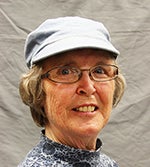Creative Connections: Trip gave taste of living in country of Cuba
Published 9:10 am Wednesday, January 18, 2017
Sara Aeikens is an Albert Lea resident.
Editor’s note: This column is continued from Jan. 9.
After a day of celebrating both Leo’s birthday and Veterans Day, we each awoke without an alarm clock. Our kind neighbors knocked on the back door around 5:30 a.m. to take us less than a mile to the bus waiting at the travel agency. We flew south in a few hours from chilly weather to tropical Florida and delighted in watching the super moon (which comes around only about every 70 years) peeking through our Miami hotel palm trees.

Sara Aeikens
By the next midday we boarded the Adonia ship with 700 passengers and sailed to Havana in our ninth-deck cabin at the aft of the ship, but we were on the sixth floor, according to the elevators. It comforted me to know the lifeboats were on our deck. We sailed mostly at night, and I found the gentle rocking aided my sleeping soundly. During our waking hours, the varied and delicious cuisine and decadent desserts became a highlight.
It helped immensely to have time on the ship while at sea to choose from a number of daily workshops on various topics, including Cuban history, culture, music, dancing lessons and art that prepared us for some of the tours at the three docking stops in Cuban cities. We spent two days in Havana, a half a day in Cienfuegos and a day in Santiago.
I especially enjoyed walking through hundreds of tiny shops in a huge marketplace in the center of Havana and speaking Spanish with the vendors, since I couldn’t use my Spanish on the ship because many of the employees, especially in food service, came from India and surrounding countries. Our tour bus guides spoke English very well and were also from numerous countries. Some guides from Cuba, as well as marketplace vendors, shared that the government paid them about $30 a month, and in order survive they had to have additional work, which for many came from their creative endeavors. I found the Cubans friendly and not insistent that we purchase their products. In fact, one sales lady gifted me a handmade nutshell bracelet after I asked her permission to take her photo.
In the main square in Santiago, I started a conversation with a 23-year-old young man whom I gave a kuk (about a dollar in U.S. money), and he agreed to answer my questions. My first inquiry was about the long, light green scarf wrapped around his neck. He told me it kept his throat open and improved his singing in the very humid 85-degree weather. He explained he sang at the Santiago Square for extra money. He shared that he had completed high school and the Cuban government paid for it entirely. If he decided to attend college, it would not cost him anything. He also said any health care he needed was paid for by the government. At that moment, another young fellow approached him and on bended knee, began serenading him in Spanish and together they completed the song “Besame Mucho.”
While touring the fortress in Santiago, we learned how Spain, around the turn of the 20th century, left Cuba because of American intervention. On all three city bus tours, we definitely could see Fidel Castro’s influence reflected in both billboard signs in Spanish and huge images of him and other Cuban heroes in all of the central city squares. The country is presently being led by Castro’s brother, Raul. With workshops and tours, I felt we got an idea what it might be like living in Cuba today. A few days after we arrived back in Albert Lea, Castro died. I am glad we were able to take one of the first cruises docking at a Cuban port, reflecting a closer relationship between the two countries and providing fascinating educational experiences involving our geographically close southern neighbor. It will be interesting to see if the Cuba/USA relationship changes much under our new national leadership and if American tourist trade to Cuba is significantly affected.

